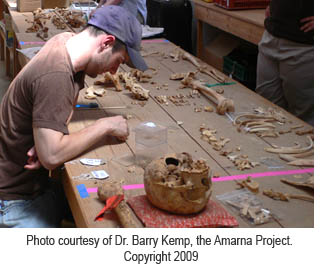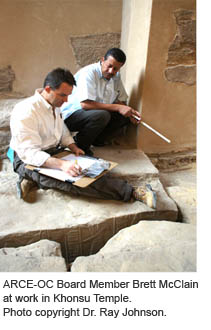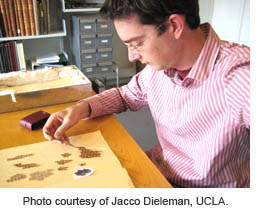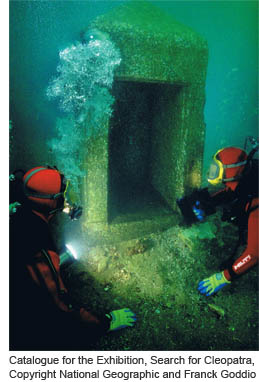|
OVERVIEW
OF EGYPTOLOGY
Egyptology is the study
of ancient Egyptian
culture, history and
society. The time span
covered by the field is
generally from the
Predynastic period, dating
to the fifth millennium
BCE, to the extinction of
the ancient religious
practices and language,
around the fourth century
CE. New research is
pushing the study of the
foundations of the
proto-Egyptian state back
into the sixth millennium
BCE.
Egyptology involves the
study of politics,
religion, art, language,
literature, medical
practices, economic and
manufacturing practices,
architecture and land use,
military dynamics, and
foreign policy. It covers
a range of diverse
interests from
agricultural and animal
husbandry practices, to
child rearing, to magic.
|
|
|
The core scientific background
of Egyptology is archaeology, but
many other scientific fields now
play an important part in the
field, including
anthropology, biology, botany,
chemistry, dendrochronology,
forensic sciences, geology,
osteology, and zoology, to name
but a few.
A host of technology-based
sciences now assist with
everything from computer imaging
and database management to
geolocation (GPS), geophysical
surveys, satellite mapping, CT
scanning, and provenance
analysis.
The most traditional, and best
known part of Egyptology, is
fieldwork: exploring and
excavating sites to uncover new
artifacts, monuments, texts, and
ancient rubbish heaps. To
learn more about fieldwork, click
here.
In addition, there are many
specialty branches of Egyptology.
To learn more about any of them,
click the links below:
Bioarchaeology
Conservation
of Artifacts and Mummies
Epigraphy
Experimental
Archaeology
Museum
Curation
Philology
Underwater
Archaeology
Note: Lectures on
many of these varied aspects of
Egyptology are part of the ARCE
Orange County chapter's free
monthly lecture series. Our
speaker schedule is available here.
 Bioarchaeology Bioarchaeology
Bioarchaeology (also known as
osteoarchaeology or
paleo-osteology) is the study of
human skeletal remains from
archaeological sites.
Bioarchaeologists can learn much
about the diet, health, and work
habits of ancient peoples by
studying mummies and skeletal
remains. They employ techniques
that are also applied in forensic
science. DNA analysis of ancient
remains is also a component of
bioarchaeology. A related field,
palaeopathology, is the study of
ancient diseases.
Back
to list
Conservation
of Artifacts, Monuments and
Mummies
 Conservation
is an important component of
Egyptology, as its primary goal is
to preserve the cultural heritage
of the world for future
generations. Conservators are
specially-trained professionals
who examine, treat, repair, and
preserve ancient artifacts and
monuments. Conservators work on
the conservation of artifacts,
buildings, or even digital media,
and may specialize in caring for
particular materials, such as
ivory, metals, pigments, or
textiles. Conservators also
preserve and conserve human and
animal remains from ancient Egypt
in the form of mummies. Learn more
about ARCE's conservation training
and projects here. Conservation
is an important component of
Egyptology, as its primary goal is
to preserve the cultural heritage
of the world for future
generations. Conservators are
specially-trained professionals
who examine, treat, repair, and
preserve ancient artifacts and
monuments. Conservators work on
the conservation of artifacts,
buildings, or even digital media,
and may specialize in caring for
particular materials, such as
ivory, metals, pigments, or
textiles. Conservators also
preserve and conserve human and
animal remains from ancient Egypt
in the form of mummies. Learn more
about ARCE's conservation training
and projects here.
Back
to list
 Education Education
Another important career choice
within Egyptology is the education
of the next generation of
Egyptologists. A vast number of
colleges and universities offer
undergraduate courses in the
Ancient Near East. A handful of US
universities offer a PhD program,
as do Japan, the United Kingdom,
France, Italy, Germany, Poland,
the Netherlands, Egypt and others.
 Epigraphy Epigraphy
Epigraphy is the study of
inscriptions (or epigraphs) as
writing. Epigraphers frequently
work on-site, reading, copying,
translating, and studying ancient
inscriptions in painstaking
detail. One of the best known and
longest-running epigraphic
projects in Egypt is the
Epigraphic Survey led by the
University of Chicago. To read
more about the Epigraphic Survey
and other ARCE-sponsored epigraphy
projects, please visit the ARCE
website and University
of Chicago Epigraphic Survey
site.
Back
to list
Experimental
Archaeology
Experimental archaeology allows
modern researchers to develop and
test hypotheses about ancient
cultures using archaeological
source material. Experimental
archaeologists utilize numerous
techniques, including creating
replica structures and artifacts
using only historically accurate
techniques and materials,
re-enacting historical events, and
burying and then excavating modern
replica material in order to
observe the impact of time and the
environment on the replicas. Some
examples of experimental
archaeology in Egypt include Mark
Lehner, Patrick McGovern, and
Delwen Samuel's bread- and
beer-making experiments, Paul T.
Nicholson's construction and
firing of experimental kilns at
Amarna, and Salima Ikram's
experiments with animal
mummification and mud trays from
KV 63.
Back
to list
Museum
Curation
Curators are specialists who are
responsible for the collections of
a museum or other cultural
heritage institution. Curators are
involved in the acquisition,
description, preservation,
interpretation, and exhibition of
works of art. They may also
conduct original research on the
collections in their care and
present their findings at
conferences, in public lectures,
or in publications.
Back
to list
 Philology Philology
Philology is the study of language
in written historical sources.
Some Egyptologists work primarily
in library and museum archives
studying ancient writings, and
hardly ever dig in the field, if
at all. Technology is making the
modern philologist's work easier
every day with large, sometimes
as-yet unstudied archives now
appearing online. One example is
the online interface called
Papyri.info https://www.papyri.info/,
which features the Papyrological
Navigator. The Papyrological
Navigator enables philologists to
simultaneously search a wide
variety of papyri housed in
collections around the world and
to retrieve digital photographs,
transcriptions, and translations
of the papyri when available.
Back
to list
Underwater
Archaeology
 Underwater
archaeology is archaeology
practiced underwater with the
assistance of divers and diving
equipment. For deeper sites,
submarines and remote sensing
tools like Remotely Operated
Vehicles (ROVs) are required.
Underwater archaeology is not only
concerned with shipwrecks, but
with all types of submerged
monuments and artifacts.
Underwater archaeology conducted
in the bay of Alexandria has
greatly advanced our understanding
of ancient Alexandria, capital of
the Ptolemaic empire. Underwater
archaeology is archaeology
practiced underwater with the
assistance of divers and diving
equipment. For deeper sites,
submarines and remote sensing
tools like Remotely Operated
Vehicles (ROVs) are required.
Underwater archaeology is not only
concerned with shipwrecks, but
with all types of submerged
monuments and artifacts.
Underwater archaeology conducted
in the bay of Alexandria has
greatly advanced our understanding
of ancient Alexandria, capital of
the Ptolemaic empire.
Back
to list
|